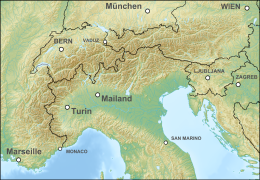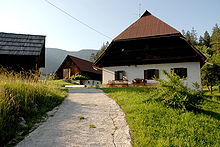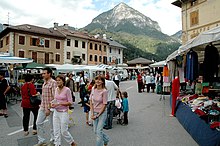Canal Valley
The Canal Valley , in Italian Val Canale , furlanic Val Cjanâl , Slovenian Kanalska dolina , is a 23 km long valley in the border triangle Italy - Austria - Slovenia with the center Tarvisio belonging to Italy and partly to Austria . The Canal Valley separates the Carnic from the Julian Alps and the Karawanken . It borders Austria in the north, Slovenia in the east and merges into the Canal del Ferro (Fella or Eisental, Dolina Bele ) in the south . The western part drains over the Fella into the Adriatic Sea , near Saifnitz ( Camporosso ) lies the inconspicuous Saifnitz watershed ( Sella di Camporosso ) - a valley watershed - to the Gailitz (Ziljica) at an altitude of 816 m slm . There the Canal Valley extends to about Thörl-Maglern or Arnoldstein .

Location and landscape
Places in the Channel Valley and Seebach Valley
The villages of the Canal Valley are from east to west:
- Fusine laghi (Weissenfelser Lakes, Slovenian : Pri Jalnu)
- Fusine in Valromana (Weißenfels, Fužine / Bela Peč)
- Aclete (Aichleiten, Ahlete)
- Ortigara in Valromana (Nesseltal, Koprivnik)
- Coccau (Goggau, Kokovo)
- Rutte (Greuth, Rute) and surroundings
- Plezzut (Flitschl, Fličl)
- Riofreddo (cold water, Mrzla voda)
- Muda (Mauth, Muta)
- Cave del Predil (Raibl, Rablelj)
- Tarvisio (Tarvis, Trbiž)
- Lussari (Luschari, Zamline)
- Camporosso (Saifnitz, Žabnice)
- Monte Lussari (Maria Luschari, Sveti Višarji) (place of pilgrimage)
- Valbruna (Wolfsbach, Ovčja vas) (in the Saisera Valley, Slovenian: Zajzera)
- Ugovizza (Uggowitz, Ukve)
- Malborghetto Valbruna (Malborgeth, Naborjet)
- Cucco (Gugg, Kuk)
- Bagni di Lusnizza (Lussnitz, Lužice) and Santa Caterina (St.Kathrein, Šentkatrija)
- San Leopoldo Laglesie (Leopoldskirchen, Dipalja vas)
- Pontebba (pontafel, tablja). The state border between Austria and Italy ran through Pontebba until 1918.
- Studena alta (Slovenian: Gornja Studena)
- Studena bassa (Slovenian: Dol.Studena)
History and culture
The Channel Valley in northern Friuli is a unique region for the Alpine region. All three major European language families - Germanic , Romance and Slavic languages - meet here directly. Austrians , Slovenes and Friulans have lived together here for centuries.
Word origin
The name Canal Valley has its roots in the Friulian word Chianâl or Cjanâl , which stands for tube-like valleys (mountain trenches).
Territorial Affiliation

After the Duchy of Carinthia was dissolved in the early late Middle Ages , the Canal Valley belonged to the Bamberg Monastery and later to the Habsburgs . In 1910 there were practically no Italian residents in the Canal Valley. Until 1918, the area was predominantly Slovene in some places, predominantly German in some places and belonged to Carinthia within the Austrian Empire and Austria-Hungary . After the end of the First World War , it was awarded to Italy by the Treaty of Saint-Germain together with the valley of Weissenfels ( Fusine , Slovenian : Fužine) and the mining town of Raibl ( Slovenian : Rabelj) and today belongs to the Friuli-Venezia Giulia region .
emigration
The guidelines for the repatriation of the Reich Germans and emigration of ethnic Germans from South Tyrol to the German Reich (see Option in South Tyrol ) from October 21, 1939 was also the ethnic Germans of mixed-language territory of Tarvisio (UD) application. 98% of the German-speaking and 91% of the Slovenian-speaking Kanaltaler decided to emigrate to the German Empire.
While in South Tyrol around 30% actually left the country as a result, the percentage of those who emigrated in the Canal Valley was around 71%.
Of 5,700 emigrants, around 5,600 spoke German and 100 spoke Slovene. So it happened that over 80% of the German-speaking Kanaltaler were resettled, while the Slovene-speaking Kanaltaler suffered only insignificant emigration losses (around 2%).
Most of the resettled people came to Carinthia : 2,700 to Villach , 1,500 to Klagenfurt , 500 to Sankt Veit an der Glan , Feldkirchen and Friesach . 500 came to the Styrian Knittelfeld and another 500 were relocated to other places. In Klagenfurt-Waidmannsdorf and Villach-Lind, the canal valley settlements that were specially built at the time are a reminder of the resettlement. About 2,500 Kanaltaler remained. Around a third of them were German speakers and two thirds were Slovenian speakers. Only about 20 of the 5,700 emigrated Canal Talers came back to the Canal Valley after the Second World War , although the Optant Decree of 1948 gave the resettled Canal Talers the opportunity to return to their homeland and regain Italian citizenship .
Today's German- and Slovene-speaking minority is mainly due to the non-resettled Kanaltaler: With a total population of around 8,000, their share is given as 20 percent.
Today's languages
The German or Slovenian speaking Kanaltaler speak their mother tongue in the respective sociolect / dialect . German is spoken as Upper Carinthian in the Villach region, and Slovenian as the Gailtal dialect (Zilja, ziljščina). Italian is the official language and Tarvisio is the center of Italian speakers.
The purely German-speaking schools (Goggau, Tarvis, Malborgeth, Pontafel) and Slovenian / German-speaking schools (Saifnitz, Uggowitz, Leopoldskirchen) of the 19th century are a thing of the past. During fascism there was only Italian as the language of instruction. After 1945 some elementary schools were allowed to teach German as an optional subject in the afternoon. In 1973, German lessons, which were initially limited to local children, were extended to all school-age children. German is now offered to all children in the morning classes (1 to 2 hours per week). Slovene afternoon classes have been taking place in Uggowitz (Ugovizza) since 1982.
Transport links
An important rail and road connection (railway: Pontebbana ; A23 / E55 motorway from Villach to Udine) from Austria to Italy runs through the Canal Valley ; Since the EU's eastward expansion , one of the main transport axes in Central Europe from Rome , Bologna and Venice to Vienna , Prague and Budapest , and one of the major Alpine transit axes, has run here .
From the 19th century onwards, modern traffic development was of decisive economic importance: the construction of the Ljubljana – Tarvis railway was completed in 1872 (the cross-border section Jesenice (Aßling) –Tarvis was closed in 1966 ); the Villach –Tarvis railway line was completed in 1873 and Tarvis– Udine in 1879. The construction of the motorway from 1973 to 1986 with the construction of 49 bridges and 18 tunnels put additional strain on the valley. The construction of the high-performance railway Pontebbana from Udine to the Austrian border (94 km) with 13 tunnels (total length 46 km, that is 48% of the route) was completed in 2000.
Due to the Schengen Agreement, there have been no more border controls at the Italy – Austria border since April 1, 1998; on December 21, 2007, they were also abandoned at the Italy – Slovenia border.
Attractions
Museo della Foresta
In 1988 the Forest Museum was opened on the A23 Udine-Tarvisio. The theme is the forest around Tarvisio, which covers an area of 24,000 hectares. The museum is surrounded by a botanical garden that houses the typical plants of this region.
Slovenian cultural center Planika / Slovensko kulturno središče Planika / Centro Culturale Sloveno Stella Alpina
In February 1997 local cultural institutions (members of the Slovenian association “Slovensko društvo Planika”, the branch of the music society “Glasbena matica”, the music school “Tomaž Holmarj” in the Canal Valley, the fund for Slovenian culture “Sklad za slovensko kulturo Ponce” and some committed personalities) and founded the Slovenian cultural center Planika Slovensko kulturno središče Planika v Kanalski dolini . This made it possible to structure, expand and improve the quality of the cultural offerings in the Kanaltal / Kanalska dolina and make it attractive to a wider audience. The cultural center Slovensko kulturno središče Planika has been an institution of primary importance for the Slovenian ethnic group in the autonomous region of Friuli-Venezia Giulia ( Italian Friuli-Venezia Giulia, Furlanian Friûl-Vignesie Julie, Slovenian Furlanija-Julijska krajina ) since June 21, 2002 Italy recognized.
See also
literature
- Matjaž Klemenčič, Kanaltal , in: Katja Sturm-Schnabl, Bojan-Ilija Schnabl (a cura di), Encyclopedia of Slovenian Cultural History in Carinthia / Koroška. From the beginning until 1942. Volume 2: J - Pl . Vienna: Böhlau, 2016, pp. 582-587
- Karin Heller, Luis Thomas Prader and Christian Prezzi (eds.): Lebendige Sprachinseln. 2nd edition, Bozen 2006. Online to the Canal Valley.
- Marko Simić: On the trail of the Isonzo front. Mohorjeva Hermagoras, Klagenfurt / Laibach / Vienna 2004, ISBN 3-85013-884-4 .
- Karl Migglautsch, Ingomar Pust: The Canal Valley and its history. Edited by the Kanaltaler Kulturverein. edition k3, Annenheim 1995, ISBN 3-901088-04-0 .
- Mario Gariup: Le opzioni per il 3 ° Reich. Val Canale 1939.
- Hans Messner: Friuli Venezia Giulia. Carinthia Klagenfurt University Press, 1990, ISBN 3-85378-350-3 .
- Gerhard Pilgram , Wilhelm Berger, Gerhard Maurer: Carinthia. Down through. Drava Verlag, Klagenfurt / Celovec 1998, ISBN 3-85435-301-4 .
- Stefanie Vavti: "We are Kanaltaler!" - Regional and local identities in the quadrilingual Valcanale in Italy. In: Forum Qualitative Social Research. Volume 7, No. 1, Art. 34 - January 2006, accessed March 5, 2007.
- Francesco Attisani et al. a .: Una strada - tre confini. La storia, l'ambiente, gli itinerari turistici del Tarvisiano e dei suoi dintorni. Giovanni Aviani Editore, Udine 1986.
- Kurt F. Strasser, Harald Waitzbauer : Across the borders to Trieste. Hikes between the Carnic Alps and the Adriatic Sea. Vienna / Cologne / Weimar 1999.
- G. Pilgram, W. Berger, W. Koroschitz, A. Pilgram-Ribitsch: The last valleys. Hiking and stopping off in Friuli. Drava Verlag, Klagenfurt / Celovec 2008, ISBN 978-3-85435-532-8 .
- Martin Wutte: The Canal Valley - La Valcanale. Verlag des Geschichtsverein für Kärnten, 2009, ISBN 978-3-85454-114-1 .
- Jakob Medved: Zemljevid z italijanskimi in slovenskimi krajevnimi imeni v Furlaniji, Julijski Krajini in Benečiji - Carta dei nomi geografici con forma italiana e slovena nel Friuli - Venezia Giulia. Mladinska knjiga, Ljubljana 1974.
- Roberto Dapit et al. a .: Ovčja vas in njena slovenska govorica, Valbruna e la sua parlata slovena. Raziskovalni tabor Kanalska dolina 2003, Stage di ricerca Val Canale 2003, Ukve - Ljubljana 2005.
media
- Hans Schabus : Val Canale . ( unikum.ac.at )
Web links
- Kanaltal Collection
- Alpine pasture and mountain hut hike from Nassfeld around the Rosskofel
- Slovensko kulturno središče Planika
Individual evidence
- ↑ Kurt F. Strasser, Harald Waitzbauer, Across the borders to Triest (Vienna 1999), p. 37.
- ↑ Roberto Dapit et al. a .: Ovčja vas in njena slovenska govorica, Valbruna e la sua parlata slovena. Raziskovalni tabor Kanalska dolina 2003, Stage di ricerca Val Canale 2003, Ukve - Ljubljana 2005.
- ^ Scuole trilingui in Val Canale incontro con il consigliere reg. del Pdl Franco Baritussio. ( Memento from July 16, 2011 in the Internet Archive )
Coordinates: 46 ° 30 ' N , 13 ° 23' E







